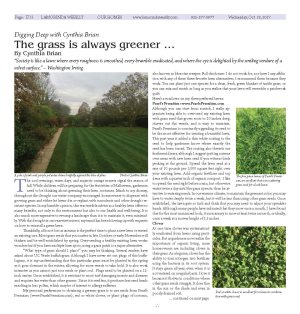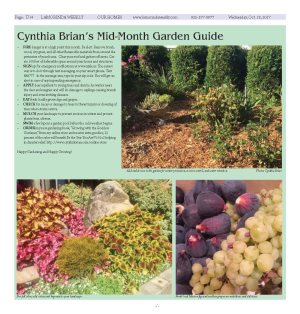|
|
Published October 18th, 2017
|
Digging Deep with Cynthia Brian
|
| The grass is always greener ... |
| By Cynthia Brian |
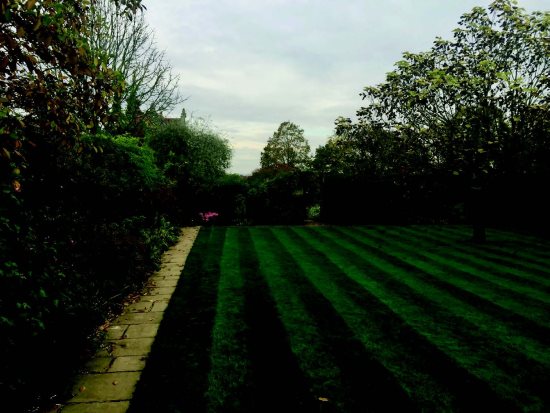 |
| A pole of pink and purple petunias shines brightly against the blue skyline. Photos Cynthia Brian |
"Society is like a lawn where every roughness is smoothed, every bramble eradicated, and where the eye is delighted by the smiling verdure of a velvet surface." - Washington Irving
 The cool evenings, warm days, and majestic orange sunsets signal the season of fall. While children will be preparing for the festivities of Halloween, gardeners need to be thinking about greening their lawn costumes. Much to my dismay, throughout the drought our water company encouraged homeowners to dispense with growing grass and either let lawns die or replant with succulents and other drought resistant species. In my humble opinion, this was terrible advice as a healthy lawn offers so many benefits, not only to the environment but also to our health and well-being. It is also much more expensive to revamp a landscape than it is to maintain it, even minimally. With the drought in our rearview mirror, my email has been blowing up with requests on how to reinstall a green lawn.
The cool evenings, warm days, and majestic orange sunsets signal the season of fall. While children will be preparing for the festivities of Halloween, gardeners need to be thinking about greening their lawn costumes. Much to my dismay, throughout the drought our water company encouraged homeowners to dispense with growing grass and either let lawns die or replant with succulents and other drought resistant species. In my humble opinion, this was terrible advice as a healthy lawn offers so many benefits, not only to the environment but also to our health and well-being. It is also much more expensive to revamp a landscape than it is to maintain it, even minimally. With the drought in our rearview mirror, my email has been blowing up with requests on how to reinstall a green lawn.
 Thankfully, all is not lost as autumn is the perfect time to plant a new lawn or reseed an existing one. Most grass seeds that you scatter in late October or early November will thicken and be well established by spring. Over-seeding a healthy existing lawn works wonders but if you have multiple bare spots, using a grass patch is a super alternative.
Thankfully, all is not lost as autumn is the perfect time to plant a new lawn or reseed an existing one. Most grass seeds that you scatter in late October or early November will thicken and be well established by spring. Over-seeding a healthy existing lawn works wonders but if you have multiple bare spots, using a grass patch is a super alternative.
 "What type of grass should I plant?" you may be thinking. Several readers have asked about UC Verde buffalograss. Although I have never set out plugs of this buffalograss, it is my understanding that this particular grass must be planted in the spring as it goes dormant in the winter, allowing for more weeds to take hold. It is also work intensive as you cannot just toss seeds or plant sod. Plugs need to be planted on a 12-inch center. Once established, it is resistant to most turf damaging insects and diseases and requires less water than other grasses. Since it is seedless, it produces less seed heads resulting in less pollen, which may be of interest to allergy sufferers.
"What type of grass should I plant?" you may be thinking. Several readers have asked about UC Verde buffalograss. Although I have never set out plugs of this buffalograss, it is my understanding that this particular grass must be planted in the spring as it goes dormant in the winter, allowing for more weeds to take hold. It is also work intensive as you cannot just toss seeds or plant sod. Plugs need to be planted on a 12-inch center. Once established, it is resistant to most turf damaging insects and diseases and requires less water than other grasses. Since it is seedless, it produces less seed heads resulting in less pollen, which may be of interest to allergy sufferers.
 My personal preferences to obtaining a greener grass is to use seeds from Pearl's Premium (www.PearlsPremium.com), red or white clover, or plant plugs of isotoma, also known as blue star creeper. Full disclosure: I do not work for, nor have I any affiliation with any of these three favorite lawn alternatives. I recommend them because they work. You can plant just one species for a clean, fresh, green blanket of tactile grass, or you can mix and match as long as you realize that your lawn will resemble a patchwork quilt.
My personal preferences to obtaining a greener grass is to use seeds from Pearl's Premium (www.PearlsPremium.com), red or white clover, or plant plugs of isotoma, also known as blue star creeper. Full disclosure: I do not work for, nor have I any affiliation with any of these three favorite lawn alternatives. I recommend them because they work. You can plant just one species for a clean, fresh, green blanket of tactile grass, or you can mix and match as long as you realize that your lawn will resemble a patchwork quilt.
 Here's a rundown on my three preferred lawns:
Here's a rundown on my three preferred lawns:
 Pearl's Premium: www.PearlsPremium.com
Pearl's Premium: www.PearlsPremium.com
 Although you can start from scratch, I really appreciate being able to over-seed my existing lawn with grass seed that grows roots to 20 inches deep, starves out the weeds, and is easy to maintain. Pearl's Premium is constantly upgrading its seed to be the most effective for creating a beautiful lawn. This past year it added a thin white coating to the seed to help gardeners know where exactly the seed has been tossed. The coating also thwarts our feathered diners, although I suggest putting screens over areas with new lawn seed if you witness birds pecking at the ground. Spread the lawn seed at a rate of 10 pounds per 1,000 square feet right over your existing lawn. Add organic fertilizer and top dress with a quarter inch of organic compost. I like to spread the seed right before a rain, but otherwise water twice a day until the grass sprouts; then be attentive to watering needs. In our warmer climate, to maintain the greenest color, you may have to water deeply twice a week, but it will be less than using other grass seeds. Once established, the lawn gets so lush and thick that you may need to adjust your sprinkler heads. Although many people have indicated that they mow once a month, I have found that for the most manicured look, it is necessary to mow at least twice a month, or ideally, once a week at a mower height of 3.5 inches.
Although you can start from scratch, I really appreciate being able to over-seed my existing lawn with grass seed that grows roots to 20 inches deep, starves out the weeds, and is easy to maintain. Pearl's Premium is constantly upgrading its seed to be the most effective for creating a beautiful lawn. This past year it added a thin white coating to the seed to help gardeners know where exactly the seed has been tossed. The coating also thwarts our feathered diners, although I suggest putting screens over areas with new lawn seed if you witness birds pecking at the ground. Spread the lawn seed at a rate of 10 pounds per 1,000 square feet right over your existing lawn. Add organic fertilizer and top dress with a quarter inch of organic compost. I like to spread the seed right before a rain, but otherwise water twice a day until the grass sprouts; then be attentive to watering needs. In our warmer climate, to maintain the greenest color, you may have to water deeply twice a week, but it will be less than using other grass seeds. Once established, the lawn gets so lush and thick that you may need to adjust your sprinkler heads. Although many people have indicated that they mow once a month, I have found that for the most manicured look, it is necessary to mow at least twice a month, or ideally, once a week at a mower height of 3.5 inches.
 Clover
Clover
 At one time clover was systematically eradicated from lawns using pesticides. But as gardeners now realize the importance of organic living, more homeowners are including clover in their grass. As a legume, clover has the ability to turn nitrogen into fertilizer using the bacteria in its root system. It stays green all year, even when it is not watered on a regular basis. I love it because it thrives in conditions where other grass seeds struggle. It does fine in the sun or the shade and even in poorly drained soil.
At one time clover was systematically eradicated from lawns using pesticides. But as gardeners now realize the importance of organic living, more homeowners are including clover in their grass. As a legume, clover has the ability to turn nitrogen into fertilizer using the bacteria in its root system. It stays green all year, even when it is not watered on a regular basis. I love it because it thrives in conditions where other grass seeds struggle. It does fine in the sun or the shade and even in poorly drained soil.
 My favorite parts of growing clover, besides its self-fertilizing system, are the beautiful pink or white flowers that crown the tops of the clover when it is left uncut. Butterflies, bees, and beneficial insects flock to clover. Don't be afraid of the honeybees as they usually don't sting when away from their hives. Clover does best when it is mixed with grass seed. I mix mine with Pearl's Premium. Try incorporating two ounces of clover for 1,000 square feet of lawn. By planting the two together, you'll have a minimum care green lawn.
My favorite parts of growing clover, besides its self-fertilizing system, are the beautiful pink or white flowers that crown the tops of the clover when it is left uncut. Butterflies, bees, and beneficial insects flock to clover. Don't be afraid of the honeybees as they usually don't sting when away from their hives. Clover does best when it is mixed with grass seed. I mix mine with Pearl's Premium. Try incorporating two ounces of clover for 1,000 square feet of lawn. By planting the two together, you'll have a minimum care green lawn.
 Isotoma-Blue Star Creeper
Isotoma-Blue Star Creeper
 This lawn substitute is best used in small areas or between stepping stones. I like it for its tiny blue star flowers that surface and shine brightly spring through summer. I would only use it in combination with clover and Pearl's Premium because I have found that in the cold months it has a tendency to look brown and ragged. It likes full sunshine, doesn't require much water, and sustains immense foot traffic, both human and animal, without damage. It sends out runners and creeps along and is especially good as a ground cover. If you like the idea of a patchwork lawn, buy a flat or two of isotoma and plant the plugs randomly throughout your existing grass as a filler and thriller.
This lawn substitute is best used in small areas or between stepping stones. I like it for its tiny blue star flowers that surface and shine brightly spring through summer. I would only use it in combination with clover and Pearl's Premium because I have found that in the cold months it has a tendency to look brown and ragged. It likes full sunshine, doesn't require much water, and sustains immense foot traffic, both human and animal, without damage. It sends out runners and creeps along and is especially good as a ground cover. If you like the idea of a patchwork lawn, buy a flat or two of isotoma and plant the plugs randomly throughout your existing grass as a filler and thriller.
 For homeowners who want instant gratification, sod is the answer. The caveat with planting sod is that the roots don't grow deeply enough and sod has a shorter lifespan. You can lengthen the longevity by over-seeding when bare spots begin appearing. By throwing seed on top of the sod, keeping the grass watered and fed, you'll be able to have a long lasting green oasis.
For homeowners who want instant gratification, sod is the answer. The caveat with planting sod is that the roots don't grow deeply enough and sod has a shorter lifespan. You can lengthen the longevity by over-seeding when bare spots begin appearing. By throwing seed on top of the sod, keeping the grass watered and fed, you'll be able to have a long lasting green oasis.

 Benefits of Maintaining a Lawn
Benefits of Maintaining a Lawn
 Although many people tend to discourage lawns in landscapes as a water conservation method, I am a firm believer that the humble grass shoot offers benefits to our health and well-being. Besides the fact that children and animals enjoy a safe, comfortable place to tumble and toss, lawns contribute to better air quality by trapping dust and smoke particles while cooling the air from the ground up. Our environments are made more habitable by the generation of oxygen absorbing the pollutants of carbon and sulfur dioxide. Lawns clean the air we breathe. Erosion is controlled because water can't carve deep recesses in a thickly planted lawn. Water filters through turf grass making our ground waters safer and cleaner for the environment. A patch of green soothes the eye in viewing a landscape, offering a resting space between the color explosions of flowers and shrubs. And a huge plus in our fire prone communities, lawns offer a buffer zone for fire prevention.
Although many people tend to discourage lawns in landscapes as a water conservation method, I am a firm believer that the humble grass shoot offers benefits to our health and well-being. Besides the fact that children and animals enjoy a safe, comfortable place to tumble and toss, lawns contribute to better air quality by trapping dust and smoke particles while cooling the air from the ground up. Our environments are made more habitable by the generation of oxygen absorbing the pollutants of carbon and sulfur dioxide. Lawns clean the air we breathe. Erosion is controlled because water can't carve deep recesses in a thickly planted lawn. Water filters through turf grass making our ground waters safer and cleaner for the environment. A patch of green soothes the eye in viewing a landscape, offering a resting space between the color explosions of flowers and shrubs. And a huge plus in our fire prone communities, lawns offer a buffer zone for fire prevention.
 The grass will only be greener if you maintain it. You'll be rewarded with better health for you and the environment. Your green grass is your safety zone. May all your roughness be smoothed as you delight in your velvet verdure.
The grass will only be greener if you maintain it. You'll be rewarded with better health for you and the environment. Your green grass is your safety zone. May all your roughness be smoothed as you delight in your velvet verdure.
 Cynthia Brian's Mid-Month Garden Guide
Cynthia Brian's Mid-Month Garden Guide
 FIRE danger is at a high point this month. Be alert. Remove brush, wood, dry grass, and all other flammable materials from around the perimeter of your home. Clear your roof and gutters of leaves. Create 100 feet of defensible space around your home and structures.
FIRE danger is at a high point this month. Be alert. Remove brush, wood, dry grass, and all other flammable materials from around the perimeter of your home. Clear your roof and gutters of leaves. Create 100 feet of defensible space around your home and structures.
 SIGN up for emergency notifications at www.nixle.us. The easiest way is to do it through text messaging on your smart phone. Text 888777. In the message area, type in your zip code. You will get an alert in case of any impending emergency.
SIGN up for emergency notifications at www.nixle.us. The easiest way is to do it through text messaging on your smart phone. Text 888777. In the message area, type in your zip code. You will get an alert in case of any impending emergency.
 APPLY deer repellent to young trees and shrubs. As winter nears the deer are hungrier and will do damage to saplings causing branch injury and even inviting diseases.
APPLY deer repellent to young trees and shrubs. As winter nears the deer are hungrier and will do damage to saplings causing branch injury and even inviting diseases.
 EAT fresh locally grown figs and grapes.
EAT fresh locally grown figs and grapes.
 CHECK for decay or damage to trees to thwart injury or downing of trees when storms arrive.
CHECK for decay or damage to trees to thwart injury or downing of trees when storms arrive.
 MULCH your landscape to prevent erosion in winter and protect plants from a freeze.
MULCH your landscape to prevent erosion in winter and protect plants from a freeze.
 SWIM a few laps in a garden pool before the cold weather begins.
SWIM a few laps in a garden pool before the cold weather begins.
 ORDER my new gardening book, "Growing with the Goddess Gardener," from my online store and receive extra goodies; 25 percent of the sales will benefit Be the Star You Are!(r) 501c3 helping in disaster relief.
http://www.cynthiabrian.com/online-store
ORDER my new gardening book, "Growing with the Goddess Gardener," from my online store and receive extra goodies; 25 percent of the sales will benefit Be the Star You Are!(r) 501c3 helping in disaster relief.
http://www.cynthiabrian.com/online-store

 Happy Gardening and Happy Growing!
Happy Gardening and Happy Growing!

 As I wrote this column, devastating fires were raging throughout California and in my home area of Napa County affecting my family, friends, and thousands of residents. My heartfelt empathy to everyone for your suffering and loss. Pray for the firefighters, first responders, evacuees, shelter volunteers and everyone who is affected by this most disastrous fire in California history. We will rise again!
As I wrote this column, devastating fires were raging throughout California and in my home area of Napa County affecting my family, friends, and thousands of residents. My heartfelt empathy to everyone for your suffering and loss. Pray for the firefighters, first responders, evacuees, shelter volunteers and everyone who is affected by this most disastrous fire in California history. We will rise again!

|
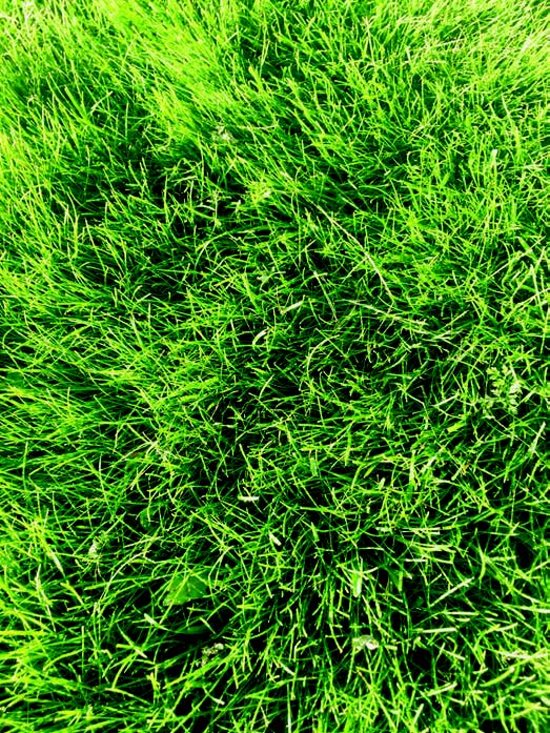 |
| The fine green leaves of Pearl's Premium, an excellent choice in scattering grass seed for a lush lawn. |
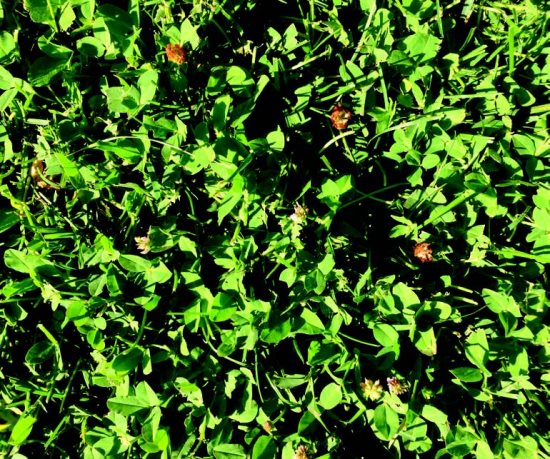 |
| Red or white clover is excellent for a lawn in combination with grass seed. |
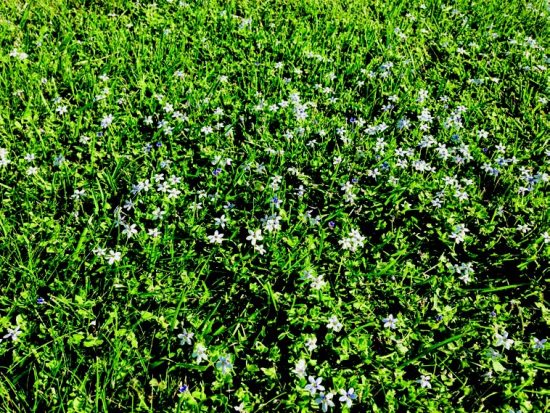 |
| The blue star flowers of isotoma are lovely as a filler in a grass seeded lawn. |
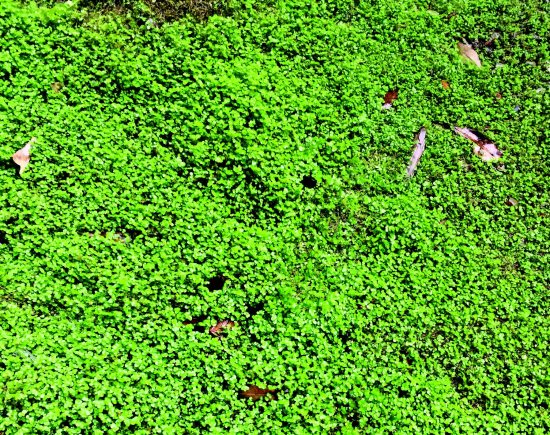 |
| As a ground cover, Baby Tears works well in the shade. It is not a lawn substitute. |
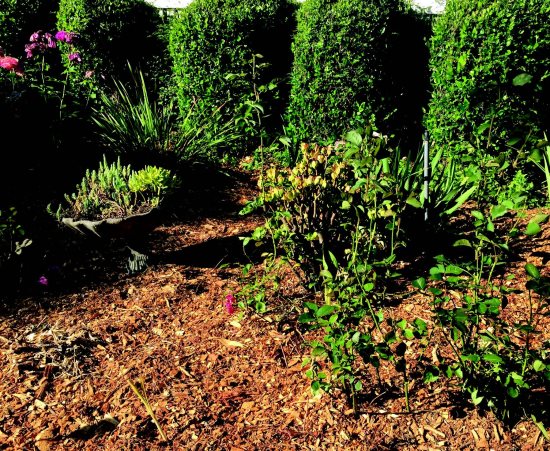 |
| Add mulch now to the garden for
winter protection, erosion control, and water retention. Photos
Cynthia Brian |
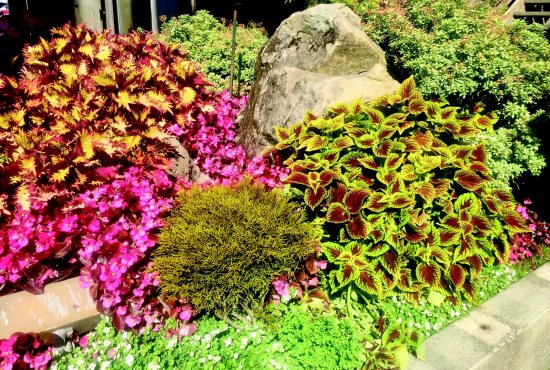 |
| For fall color, add coleus and begonias to your landscape. |
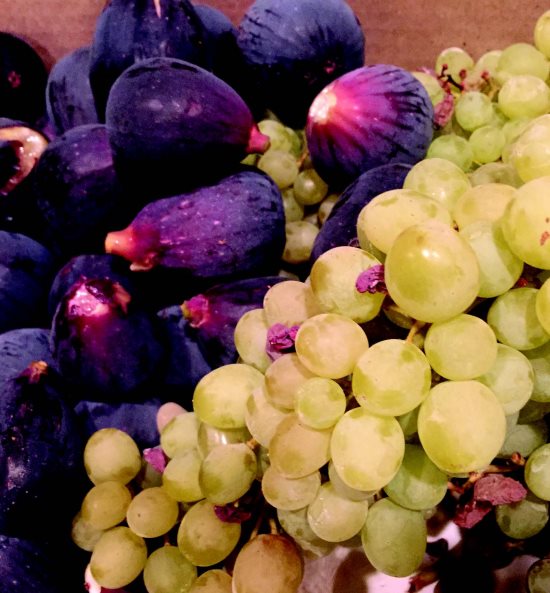 |
| Fresh local Mission figs and seedless grapes are nutritious and
delicious. |
 |
| Cynthia Brian sits on her porch. |
| The Goddess Gardener, raised in the vineyards of Napa County, is a
New York Times best selling author, actor, radio personality, speaker,
media and writing coach as well as the Founder and Executive Director
of Be the Star You Are1(r) 501 c3. Please make a donation to help with
hurricane disaster relief at
www.BetheStarYouAre.org. Tune into Cynthia's Radio show and order
her books at
www.StarStyleRadio.com. My new book, "Growing with the Goddess
Gardener," is available at
www.cynthiabrian.com/online-store. Available for hire for any
gardening project.
Cynthia@GoddessGardener.com
www.GoddessGardener.com |
| |
| |
| |
| |
|
|











